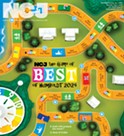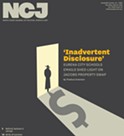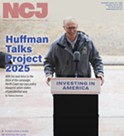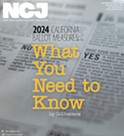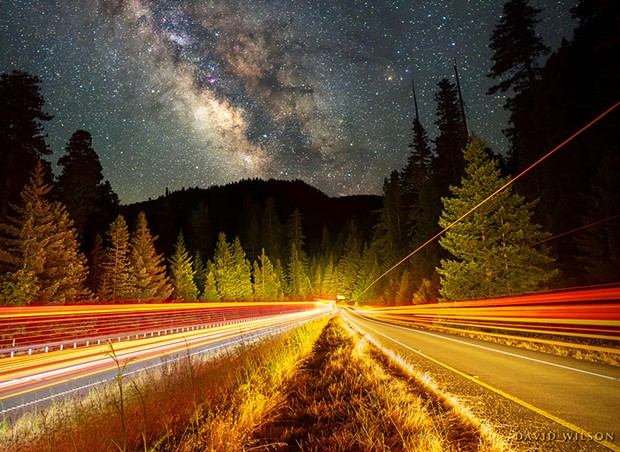
A view beside the on-ramp to southbound U.S. Highway 101 from Vista Point. The Milky Way converges in the distance with the streaking taillights of semi trucks passing by on the left and right. Just around the distant corner is the entrance to the north end of the Avenue of the Giants. All the light of the landscape was provided, like paint strokes, by the passing trucks. June 30, 2024.
[
{
"name": "Top Stories Video Pair",
"insertPoint": "7",
"component": "17087298",
"parentWrapperClass": "fdn-ads-inline-content-block",
"requiredCountToDisplay": "1"
}
]
Beneath the majestic Milky Way, Vista Point scenic overlook along southbound U.S. Highway 101 lies among the Redwoods of Humboldt County, just south of Stafford, California.
The primary image in this story was photographed next to the on-ramp, and immediately behind the camera is the overlook itself. This is an example of light painting photography. In this case the light was painted into the nighttime scene by passing vehicles. I've dabbled with light painting since about 1990, when I was a photography student using a 35mm film camera at Humboldt State University. In those, I usually paint the light myself with flashlights or other light sources, controlling how the light falls. In this image, I allowed the vehicles to paint the light in as they may. And this they did.
While painting with light is always an experiment, I've gotten a little better predicting how it will work out. I discovered long ago that when cars and trucks pass by, they add light to the landscape and reveal its hidden details, much as a painter adds strokes of paint to a canvas to reveal the details of imagination. That's what we are seeing in this image.
Each stroke of light from the headlights exposed detail in the otherwise black landscape, while the taillights created dramatic light streaks. Photographing under these circumstances creates images that you absolutely cannot see with the naked eye — your eye doesn't see the light streaks, and the landscape is only illuminated where the car is at any given instant. But with a long-exposure photograph, the light turns to streaks and landscape detail is illuminated along the entire path of the vehicle. On top of that, the long exposure allows the camera to see the Milky Way and the night sky in more detail and more color than our eyes can see. Capturing photographs in this way almost feels like magic; using the camera like this allows it to see in ways that we cannot.
I was with my photo buddy Tim Loe the night I photographed this. Tim is a former Digital Photography student of mine at College of the Redwoods. We watched and photographed as the stars and Milky Way crawled slowly across the sky. My plan was to wait until the Milky Way reached this point of convergence with the lines made by the roads, the tree line and the streaks of light for the drama it would create.
Over the course of three hours, we stood beside the on-ramp and photographed cars and semis going by, waiting for the Milky Way to creep across the horizon from left to right until it reached this point where all lines converged. That was my vision and I knew it would happen around 11:30 p.m. at this time of year. I'd been aware of this possible lineup for a couple years but I missed going out to capture it the last two seasons.
This photographic image was illuminated in three parts: The light streaks and the light on the landscape on the left are from one extremely well-lit semi going south on the highway, while the lights on the right are from another semi that towered over us as it drove down the on-ramp toward U.S. Highway 101 south. The two semis provided the light streaks and the light for the landscape in two separate photos. For the perfect sky, I waited until the Milky Way reached that spot to line up with the two roads, then took a photograph specifically for the sky without cars in the frame. I never moved the camera all night, with the result that each photograph applied the light it captured to a different part of the image. This is a combination of the three.
I took many photos that evening, some without vehicles going by. The photographs without cars or trucks were straight nighttime long-exposure photographs, with no light painted into them. In those, the landscape is black and the skyline is a silhouette.
Technical details of the image, for those who want to know: The photo of the sky and horizon was 25 sec, f/2.8, ISO 6400. The photo comprising the landscape and light streaks on the highway on the left was 25 sec, f/4.5, ISO 640. The photograph that captured the light on the right was exposed for 68 sec, f/4.5, and ISO 2500. Every shot was photographed with a Nikon Z8 with a 14-24mm F-mount Nikkor lens (with FTZ adapter) at 14mm. The camera never moved and the lens stayed at the same focal length throughout the series, so that the view was precisely the same for each shot.
To keep abreast of David Wilson's (he/him) most current photography, visit or contact him at his website mindscapefx.com or follow him on Instagram at @david_wilson_mfx. David teaches Art 35 Digital Photography at College of the Redwoods.




